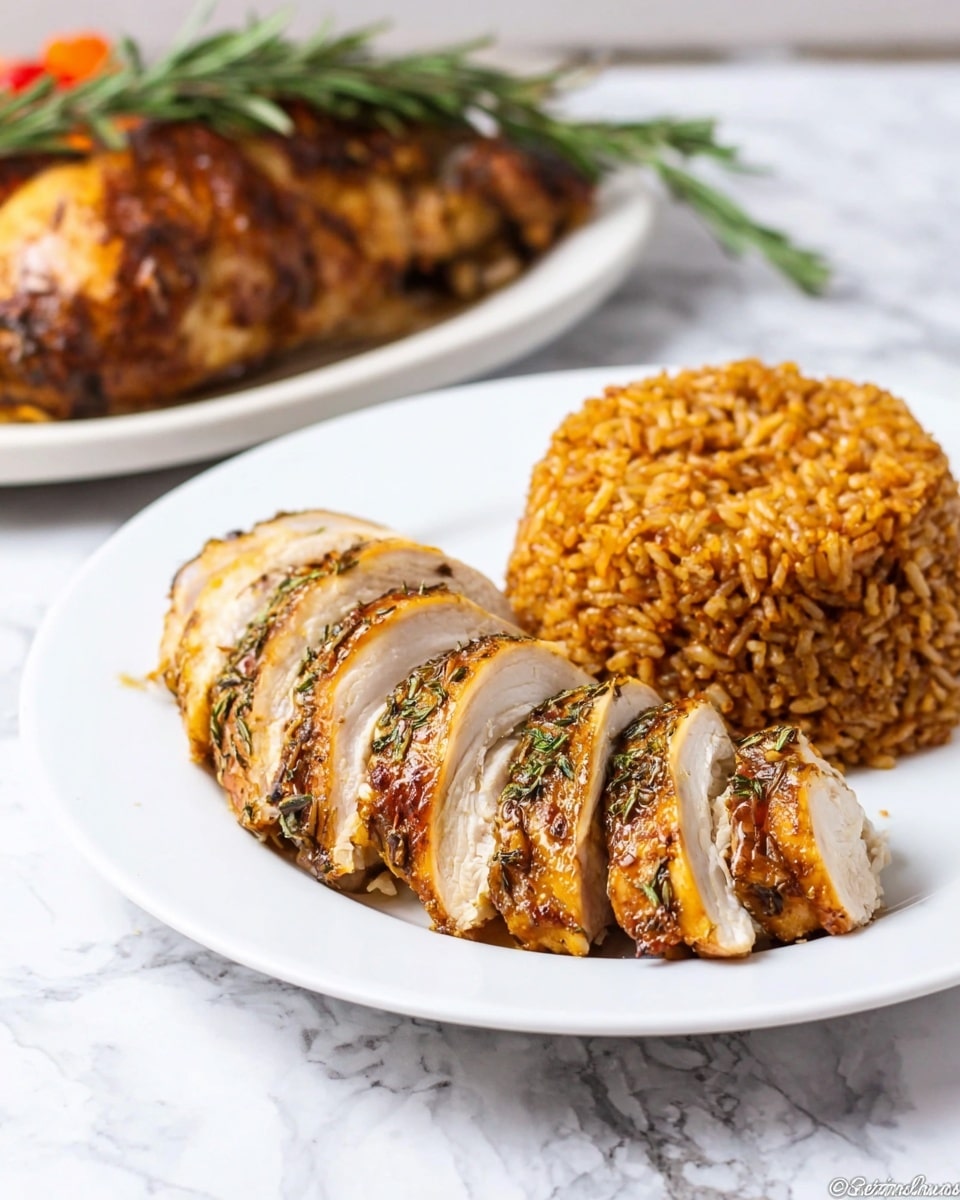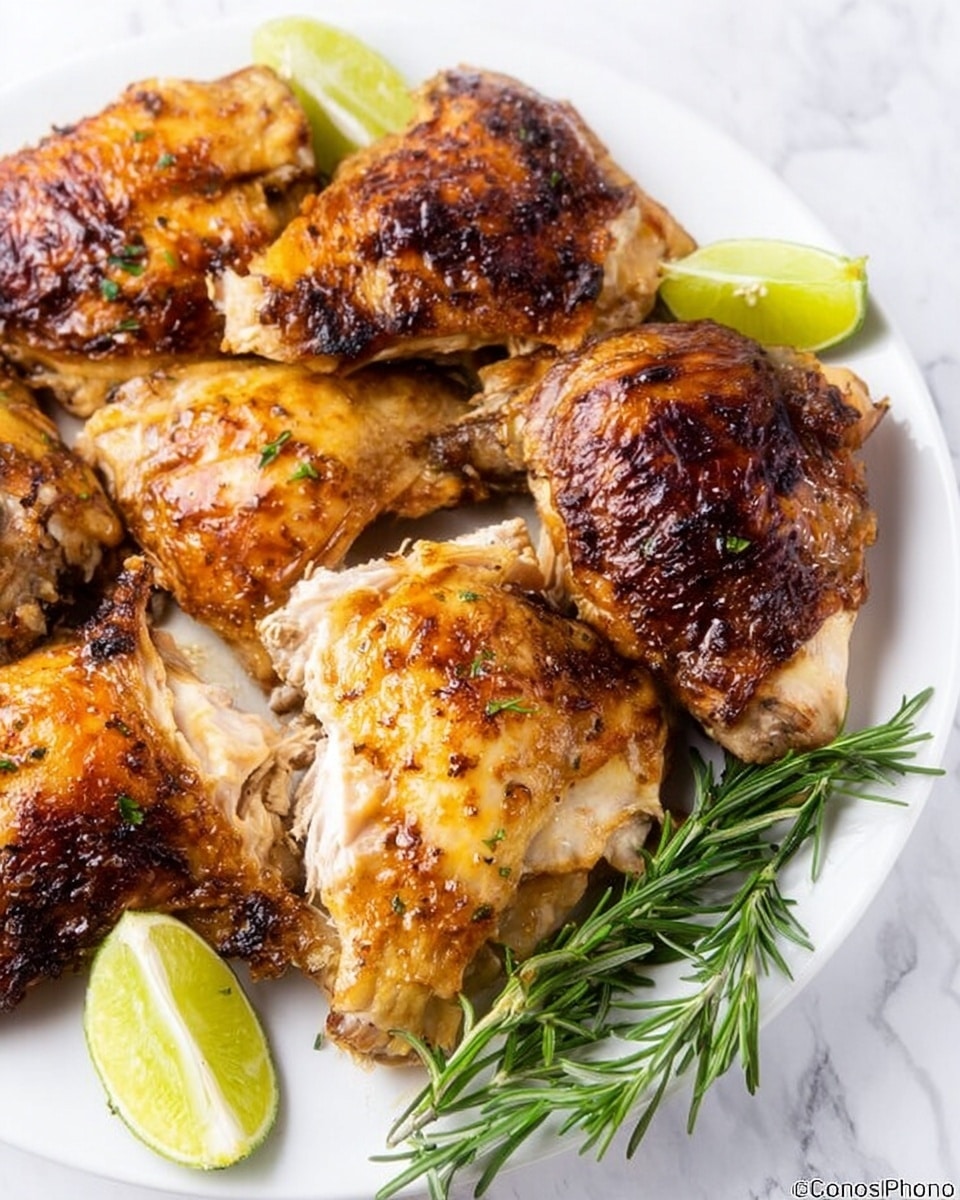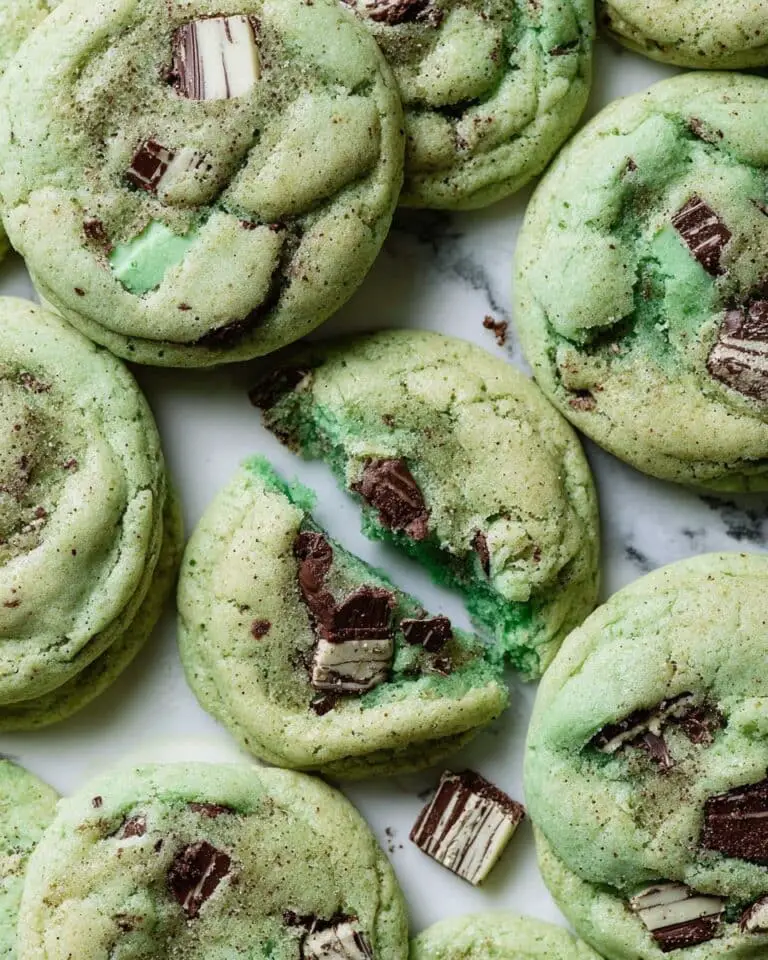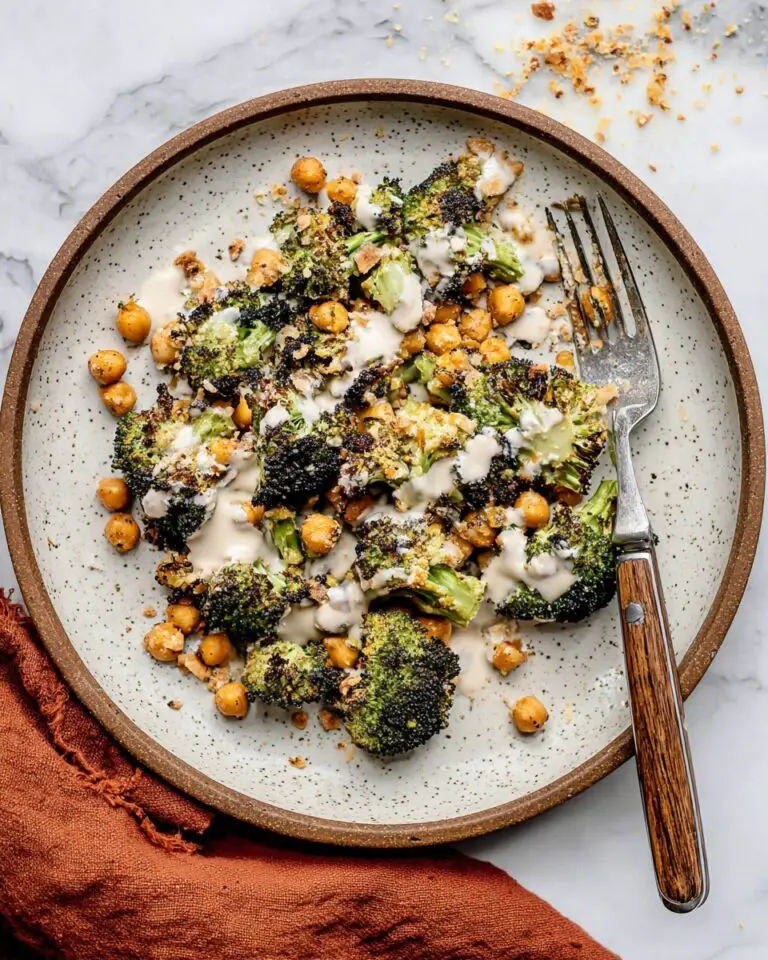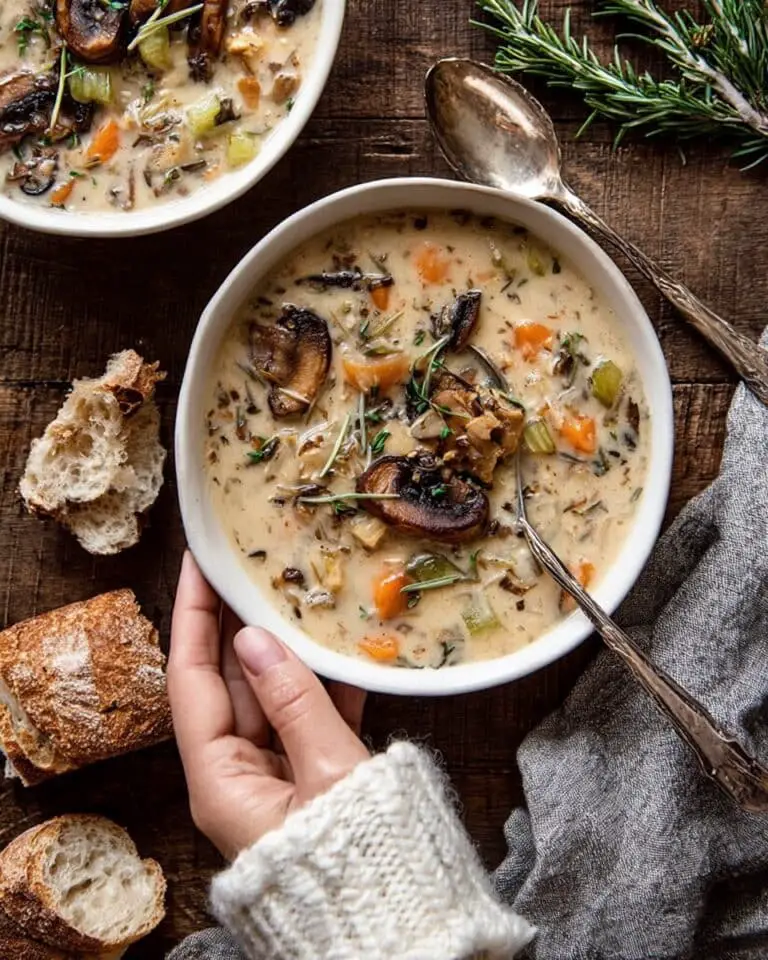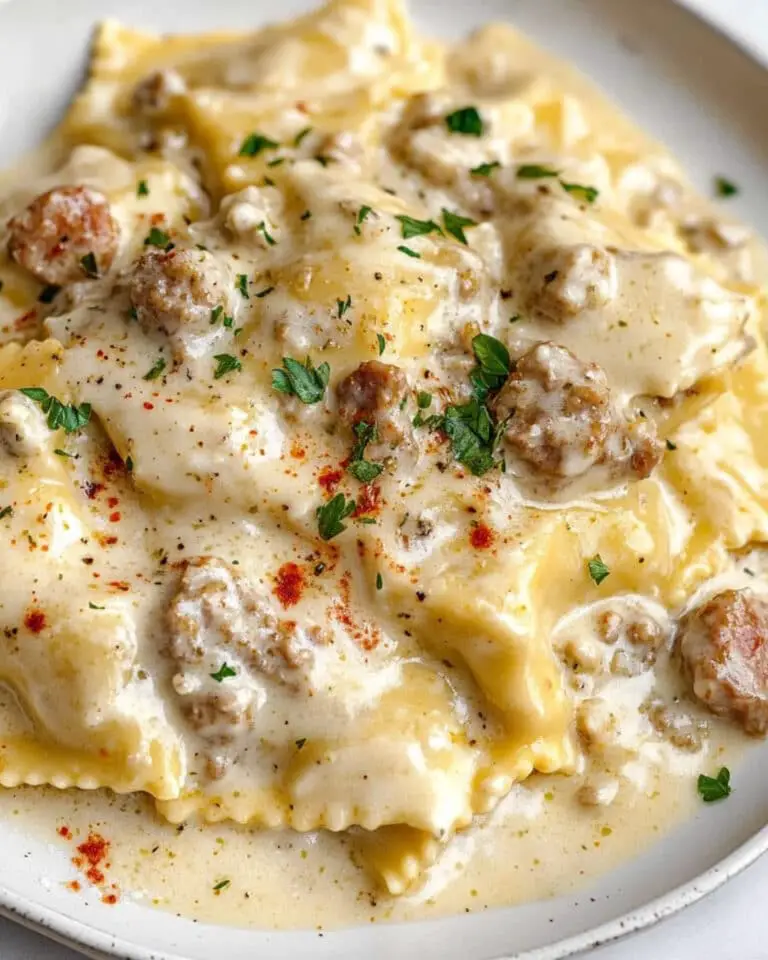If you’re hunting for The Best Juicy Roast Turkey Recipe, I promise you’ve just stumbled on a real winner. This recipe has been my go-to for holidays and special family meals, especially when I want that perfect balance of crispy skin with juicy, flavorful meat inside. The magic lies in the marinade and the injection technique, which I learned after years of trying to avoid dry turkey — and let me tell you, once you get it right, there’s no turning back.
Whether it’s Thanksgiving, Christmas, or a big Sunday dinner, this method will have everyone asking for seconds. You’ll find that even the leftovers stay moist and tasty (if there are any left, that is!). Trust me, following these steps will make your bird the star of the table every time.
Why You’ll Love This Recipe
- Juiciness Guaranteed: The secret flavor injector method keeps the meat incredibly moist and tender throughout roasting.
- Bold, Balanced Flavors: Fresh herbs, garlic, and ginger combine for a bright, savory taste that complements the turkey perfectly.
- Simple Ingredients, Amazing Results: No fancy shop-bought marinades here—just wholesome, fresh ingredients that work wonders.
- Perfect for Big Gatherings: This 12-pound turkey feeds a crowd and leaves everyone happy, with minimal effort involved.
Ingredients You’ll Need
All of the ingredients in The Best Juicy Roast Turkey Recipe are easy to find and work beautifully together to infuse your turkey with layers of flavor. Using fresh herbs and aromatics makes a huge difference, so don’t skip the rosemary, thyme, garlic, and ginger.
- Turkey: A 12-pound thawed turkey at room temperature ensures even cooking and juicy meat.
- Garlic cloves: Fresh and peeled, they add wonderful savory depth to the marinade.
- Ginger root: Gives a subtle zing balancing the garlic nicely.
- Fresh rosemary: Choose whole sprigs, you’ll strip the needles for an intense herbal note.
- Fresh thyme: Adds an earthy, fragrant touch that complements the other herbs.
- Onion: Chopped roughly, it melts into the spice blend for richer flavor.
- Seasoning cubes (Maggi): These add umami and seasoning boost to the marinade.
- Ground white and black pepper: Brings warmth and subtle heat.
- Salt: Essential both in the marinade and rubbing; enhances all other flavors.
- Extra virgin olive oil: Helps to bind the flavors and keeps the butter mixture smooth.
- Unsalted butter: Room temperature for easy mixing and rich basting flavors.
- Flavor injector: A small tool that injects marinade deep inside for maximum juiciness.
- Roasting bowl or pan: To hold your turkey and catch those delicious juices while roasting.
Variations
I love making this recipe just as is, but sometimes I like to tweak it based on what I have on hand or the flavor profiles my guests enjoy. Don’t hesitate to customize — it’s your turkey after all!
- Herb Variations: I’ve swapped rosemary and thyme for sage or oregano with great results—these give a slightly different herbal aroma but keep the juicy texture intact.
- Spicy Kick: Adding a small amount of cayenne or smoked paprika to the marinade really livens up the flavor without overpowering it.
- Butter Substitutes: Sometimes I use compound butter infused with lemon zest or fresh herbs for added richness.
- Dietary Adaptations: For those avoiding butter, olive oil can be increased slightly and mixed with garlic and herbs as a rub to keep things moist.
How to Make The Best Juicy Roast Turkey Recipe
Step 1: Prep Your Turkey and Make the Spice Blend
Start by washing your turkey thoroughly and patting it dry—this step is crucial because a dry surface helps the skin crisp up beautifully. Then lay the turkey in your roasting pan or tray. While it rests, strip the rosemary needles and thyme leaves and pop them into your blender along with peeled garlic cloves, ginger root, chopped onion, seasoning cubes, and both peppers with about half a cup of water. Blend it all into a smooth, fragrant paste.
Step 2: Separate and Season Your Spice Blend
Push the spice blend through a fine sieve to separate the liquid from the bits (or chaff). You should get about 8 ounces of the flavorful liquid—if not, rinse the bits with a little water again to get more. Add a quarter teaspoon of salt and a tablespoon of olive oil to the liquid; for the chaff, add three-quarters teaspoon of salt, a tablespoon of olive oil, and your softened butter, then mix well. This butter-spice paste is what you’ll rub all over your turkey later.
Step 3: Inject and Rub the Turkey
Using a flavor injector, draw up the spiced liquid and inject it generously into the turkey breasts and thighs—about 2 ounces per breast and 1 ounce per thigh. You’ll probably see a little spillover when pulling the injector out, but that’s totally normal. After injecting, massage the butter-spice mixture all over the turkey, inside and out, making sure you get into every nook and cranny. Don’t worry if the paste slides a bit; some of it will melt into the skin and help with flavor and browning.
Step 4: Marinate and Roast
Cover your turkey tightly with plastic wrap and pop it into the fridge to marinate for at least 8 hours—overnight is even better. I once left mine almost 24 hours, and the flavor was next-level delicious. When you’re ready to roast, take it out and let it come to room temperature while you preheat your oven to 350°F (180°C). Place the turkey in the oven on the lower-middle rack.
Step 5: Baste Regularly for Juicy, Crispy Skin
After the first hour of roasting, baste your turkey by scooping up the juices from the pan and pouring them over the bird. Keep doing this every 30 minutes—four times in total. This basting ritual keeps the skin crispy and the meat moist. If the turkey gets too brown, just tent some aluminum foil over the top to protect it without cooling the oven too much.
Step 6: Check Temperature and Rest
Roast the turkey for about 2½ to 3 hours, but don’t rely on timing alone. Use a digital thermometer to check the thickest part of the meat—it should read 175°F (79°C) for perfectly cooked poultry. Once done, let the turkey rest in its own juices for 20 to 30 minutes before carving. This step is key to locking in those juices for melt-in-your-mouth tenderness.
Pro Tips for Making The Best Juicy Roast Turkey Recipe
- Inject Generously: Don’t be shy when using the flavor injector; it’s what truly locks in moisture and flavor deep inside the meat.
- Let it Rest at Room Temperature: Taking the turkey out of the fridge at least 30 minutes before roasting helps it cook evenly.
- Baste, Baste, Baste: Regular basting is not just tradition—it prevents drying and yields that golden, crispy skin everyone loves.
- Use a Thermometer: Rely on an internal temperature check—not cooking time—to avoid over- or under-cooking your turkey.
How to Serve The Best Juicy Roast Turkey Recipe
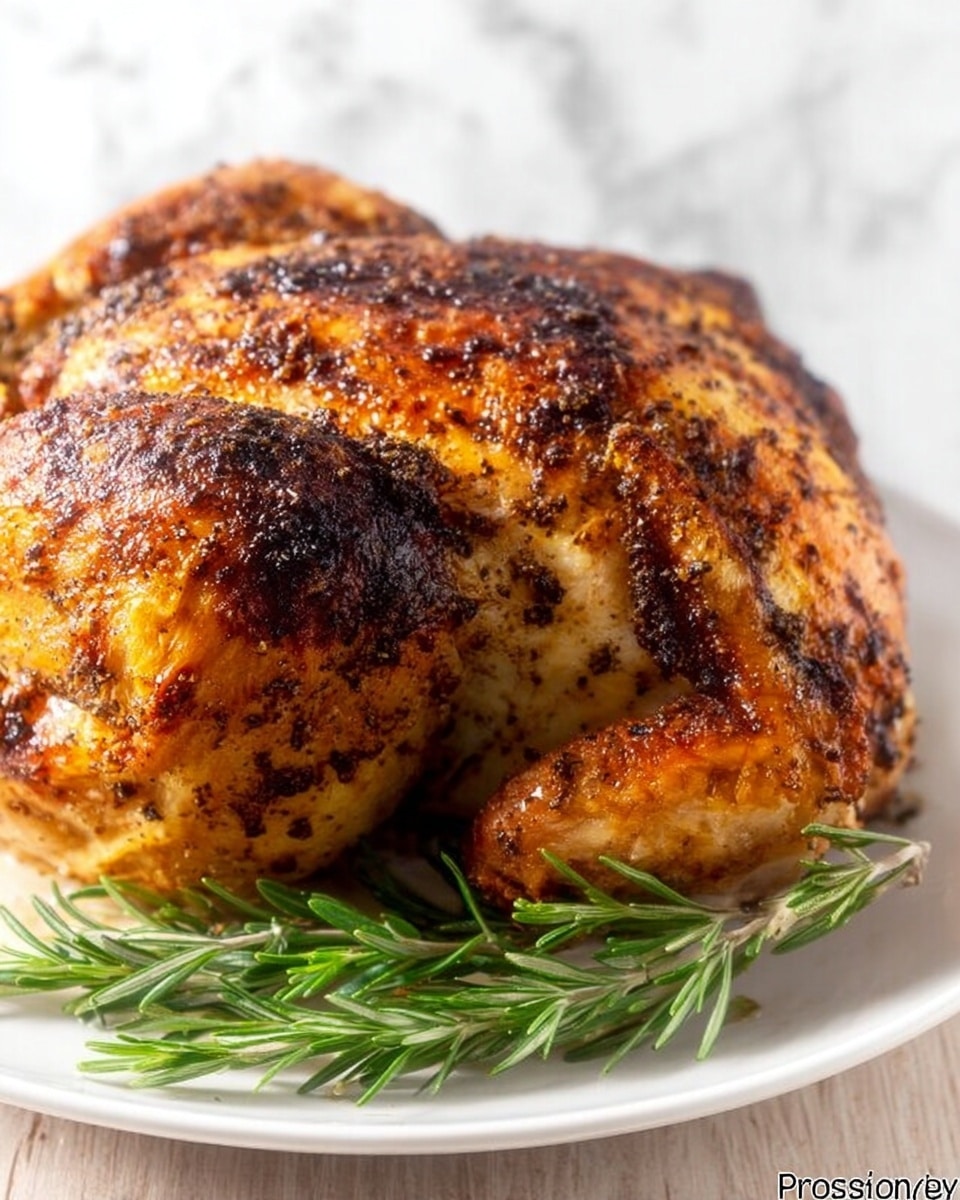
Garnishes
I like to garnish this roast turkey with fresh sprigs of rosemary and thyme tucked around the platter—it gives a beautiful aroma and a festive look that’s sure to impress. A few lemon wedges on the side also brighten the presentation and add a zesty option for guests.
Side Dishes
This turkey pairs perfectly with classic sides like creamy mashed potatoes, buttery green beans, and a rich gravy made from those wonderful pan drippings. My family goes crazy for roasted root vegetables and a tangy cranberry sauce to cut through the richness.
Creative Ways to Present
For special occasions, I sometimes carve the turkey into thick slices and arrange them on a large wooden board with fresh herbs, nuts, and seasonal fruits like sliced apples or figs. It creates a rustic, inviting vibe that encourages sharing and chatting around the table.
Make Ahead and Storage
Storing Leftovers
After the feast, I let the turkey cool slightly before wrapping it tightly in foil or placing it in airtight containers. Leftovers stored this way in the fridge stay tender and flavorful for up to 4 days, making easy meals for afterwards.
Freezing
I’ve frozen cooked turkey before by slicing it and layering pieces with parchment paper in freezer-safe bags. It holds up well and thaws overnight in the fridge, perfect for quick lunches or sandwiches later on.
Reheating
To reheat, I prefer gently warming the turkey in a low oven (about 300°F) covered with foil to keep the moisture in. This method helps maintain tenderness far better than microwaving, which can dry it out quickly.
FAQs
-
Can I use this recipe with a bigger or smaller turkey?
Absolutely! For larger turkeys, just increase the marinade amounts proportionally. Smaller birds may take less cooking time, so keep an eye on the temperature to ensure it’s cooked through without drying out.
-
Do I have to use a flavor injector?
The injector really is the magic behind the juiciness, helping the marinade penetrate the meat deeply. If you don’t have one, you can marinate longer and rub the butter mixture under the skin to add flavor and moisture, but the results won’t be quite the same.
-
How do I know when the turkey is fully cooked?
Using a digital meat thermometer is the best way. Insert it into the thickest part of the breast or thigh, and once it reads 175°F (79°C), your turkey is safe and ready to serve.
-
Can I prepare the turkey the day before?
Yes! Marinating the turkey overnight or up to 24 hours ahead is encouraged, as it allows the flavors to fully soak in and the meat to tenderize beautifully.
-
What if I don’t have fresh herbs?
Dried herbs can work in a pinch, but fresh rosemary and thyme give a brighter, fresher flavor. If using dried, reduce the quantity slightly, since they’re more concentrated and can easily overpower.
Final Thoughts
This recipe really has a special place in my heart because it transformed my turkey roasting game from “meh” to magnificent. If you want a centerpiece that’s juicy, flavorful, and a guaranteed crowd-pleaser, give The Best Juicy Roast Turkey Recipe a try. I’m confident it’ll become a beloved favorite at your table too—just remember to enjoy the process as much as the feast itself!
Print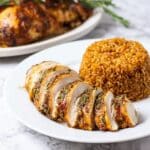
The Best Juicy Roast Turkey Recipe
- Prep Time: 30 minutes
- Cook Time: 150 minutes
- Total Time: 180 minutes
- Yield: 10 servings
- Category: Main Course
- Method: Baking
- Cuisine: American
Description
This recipe for The Best Juicy Roast Turkey delivers a perfectly seasoned, tender, and flavorful turkey with a crispy skin. Marinated with fresh herbs, garlic, ginger, and a blend of spices, then roasted slowly in the oven to achieve a juicy inside and golden outside. Ideal for festive occasions or family dinners, this method ensures every bite is moist and delicious.
Ingredients
Main Ingredients
- 1 turkey (12 pounds), thawed and at room temperature
- 10 cloves garlic, peeled
- 1 1/2 inch ginger root, peeled
- 2 sprigs fresh rosemary
- 6 sprigs fresh thyme
- 1 medium onion, peeled and roughly chopped
- 2 seasoning cubes (Maggi, about 4g per cube)
- 1/2 teaspoon ground white pepper
- 1/2 teaspoon ground black pepper
- 1 teaspoon salt
- 2 tablespoons extra virgin olive oil
- 4 tablespoons unsalted butter, at room temperature
Equipment
- 1 flavor injector
- 1 roasting bowl for the turkey
Instructions
- Prepare the Turkey: Wash the turkey thoroughly and pat dry with paper towels. Place it in a large roasting tray to make it ready for seasoning.
- Make the Spice Paste: Strip the rosemary needles and thyme leaves. Add them to a blender along with garlic, ginger, onions, white and black pepper, seasoning cubes, and about half a cup of water. Blend until it forms a smooth paste.
- Separate Spice Liquid and Chaff: Pass the blended spice mixture through a fine sieve, pressing out the liquid into one bowl and collecting the solid chaff in another. Rinse the chaff to yield approximately 8 ounces (about 1 cup) of spice liquid.
- Season and Oil Mixtures: Add 1/4 teaspoon salt and 1 tablespoon olive oil to the spice liquid, then whisk well. Add 3/4 teaspoon salt, 1 tablespoon olive oil, and the butter to the spice chaff, mixing thoroughly to create the butter mixture.
- Inject the Turkey: Use the flavor injector to draw up the spice liquid and inject about 2 ounces into each turkey breast, 1 ounce into each thigh, and then into other meaty areas. Expect some spillover as you withdraw the injector.
- Apply Butter Mixture: Rub the butter mixture liberally all over the turkey, including inside the cavity and hard-to-reach spots, ensuring even coverage.
- Marinate: Cover the turkey tightly with plastic wrap and refrigerate for at least 8 hours, preferably overnight or up to 24 hours for maximum flavor infusion.
- Preheat Oven and Prepare for Roasting: Remove the turkey from the fridge and let it come to room temperature. Preheat your oven to 350°F (180°C). Place the turkey in the lower middle rack of the oven, uncovered.
- Roast and Baste: Roast the turkey for about 2.5 to 3 hours total. After the first hour, baste using the turkey’s own juices. Continue basting every 30 minutes, about four times in total. If the skin browns too quickly, cover the turkey loosely with aluminum foil.
- Check for Doneness: Insert a digital thermometer into the thickest part of the turkey. The internal temperature should register 175°F (80°C) to confirm it’s fully cooked.
- Rest Before Serving: Remove the turkey from the oven and let it rest in its juices for 20 to 30 minutes before carving to retain moisture and flavor.
- Serve: Transfer the turkey to a serving platter or cutting board. Carve and enjoy the best juicy roast turkey with your choice of sides.
Notes
- This method produces the juiciest and most flavorful roast turkey, with a crispy skin and well-seasoned meat throughout.
- Using a flavor injector distributes the marinade deep into the meat, enhancing moisture and taste.
- Allowing the turkey to marinate for at least 8 hours, preferably overnight, greatly improves flavor absorption.
- Basting frequently during roasting prevents dryness and promotes an evenly browned, crispy exterior.
- If the turkey browns too fast, covering it with foil protects the skin without interrupting cooking.
- Resting the turkey before carving lets the juices redistribute, resulting in tender, succulent meat.
Nutrition
- Serving Size: 1 serving
- Calories: 687
- Sugar: 1 g
- Sodium: 1069 mg
- Fat: 18 g
- Saturated Fat: 6 g
- Unsaturated Fat: 9 g
- Trans Fat: 0.2 g
- Carbohydrates: 3 g
- Fiber: 0.4 g
- Protein: 124 g
- Cholesterol: 377 mg

